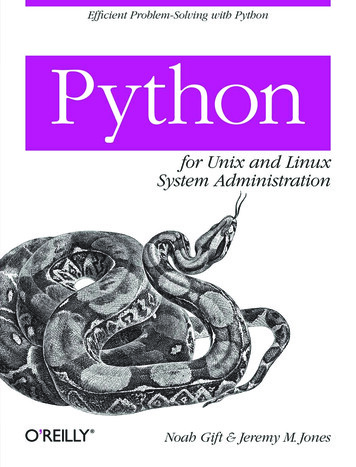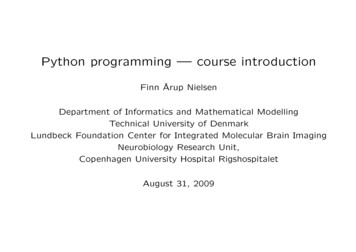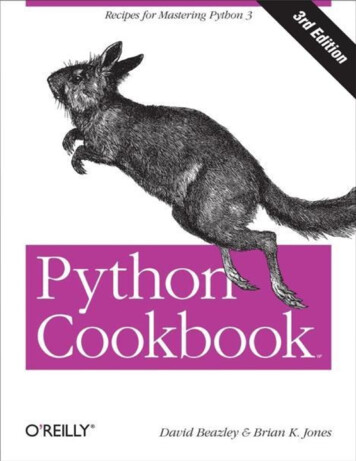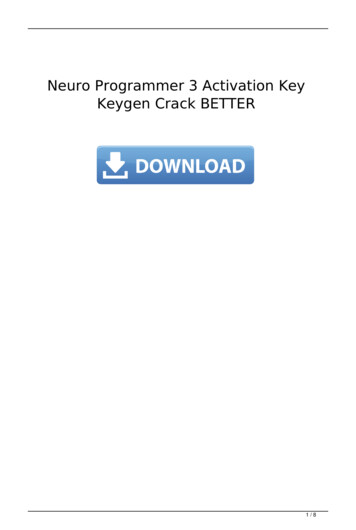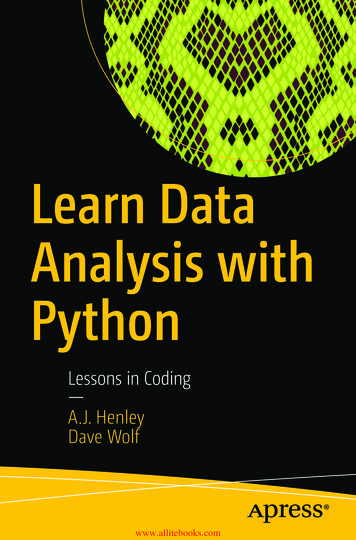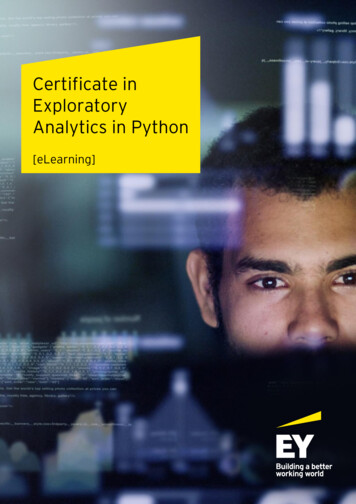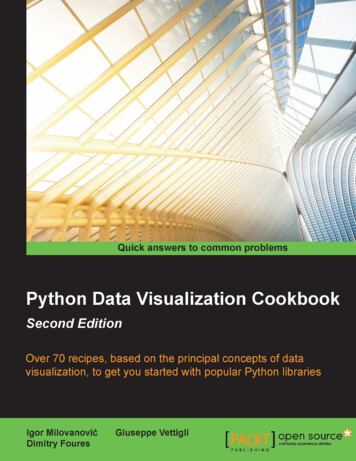
Transcription
Python Data VisualizationCookbookSecond EditionOver 70 recipes, based on the principal conceptsof data visualization, to get you started with popularPython librariesIgor MilovanovićDimitry FouresGiuseppe VettigliBIRMINGHAM - MUMBAI
Python Data Visualization CookbookSecond EditionCopyright 2015 Packt PublishingAll rights reserved. No part of this book may be reproduced, stored in a retrieval system,or transmitted in any form or by any means, without the prior written permission of thepublisher, except in the case of brief quotations embedded in critical articles or reviews.Every effort has been made in the preparation of this book to ensure the accuracy of theinformation presented. However, the information contained in this book is sold withoutwarranty, either express or implied. Neither the authors, nor Packt Publishing, and itsdealers and distributors will be held liable for any damages caused or alleged to becaused directly or indirectly by this book.Packt Publishing has endeavored to provide trademark information about all of thecompanies and products mentioned in this book by the appropriate use of capitals.However, Packt Publishing cannot guarantee the accuracy of this information.First published: November 2013Second edition: November 2015Production reference: 1261115Published by Packt Publishing Ltd.Livery Place35 Livery StreetBirmingham B3 2PB, UK.ISBN 978-1-78439-669-5www.packtpub.com
CreditsAuthorsIgor MilovanovićProject CoordinatorNidhi JoshiDimitry FouresGiuseppe VettigliReviewerKostiantyn KucherCommissioning EditorAkram HussainAcquisition EditorMeeta RajaniContent Development EditorMayur PawanikarTechnical EditorAnushree Arun TendulkarCopy EditorCharlotte CarneiroProofreaderSafis EditingIndexerRekha NairGraphicsJason MonteiroProduction CoordinatorManu JosephCover WorkManu Joseph
About the AuthorsIgor Milovanović is an experienced developer, with strong background in Linux systemknowledge and software engineering education, he is skilled in building scalable data-drivendistributed software rich systems.Evangelist for high-quality systems design who holds strong interests in software architectureand development methodologies, Igor is always persistent on advocating methodologieswhich promote high-quality software, such as test-driven development, one-step builds andcontinuous integration.He also possesses solid knowledge of product development. Having field experience andofficial training, he is capable of transferring knowledge and communication flow frombusiness to developers and vice versa.Igor is most grateful to his girlfriend for letting him spent hours on the work instead withher and being avid listener to his endless book monologues. He thanks his brother forbeing the strongest supporter. He is thankful to his parents to let him develop in variousways and become a person he is today.Dimitry Foures is a data scientist with a background in applied mathematics andtheoretical physics. After completing his undergraduate studies in physics at ENS Lyon(France), he studied fluid mechanics at École Polytechnique in Paris where he obtaineda first class master's. He holds a PhD in applied mathematics from the University ofCambridge. He currently works as a data scientist for a smart-energy startup inCambridge, in close collaboration with the university.Giuseppe Vettigli is a data scientist who has worked in the research industry andacademia for many years. His work is focused on the development of machine learningmodels and applications to use information from structured and unstructured data.He also writes about scientific computing and data visualization in Python on his blogat http://glowingpython.blogspot.com.
About the ReviewerKostiantyn Kucher was born in Odessa, Ukraine. He received his master's degree incomputer science from Odessa National Polytechnic University in 2012, and he has usedPython as well as matplotlib and PIL for machine learning and image recognition purposes.Since 2013, Kostiantyn has been a PhD student in computer science specializing in informationvisualization. He conducts his research under the supervision of Prof. Dr. Andreas Kerren withthe ISOVIS group at the Computer Science department of Linnaeus University (Växjö, Sweden).Kostiantyn was a technical reviewer for the first edition of this book.
www.PacktPub.comSupport files, eBooks, discount offers, and moreFor support files and downloads related to your book, please visit www.PacktPub.com.Did you know that Packt offers eBook versions of every book published, with PDF and ePubfiles available? You can upgrade to the eBook version at www.PacktPub.com and as a printbook customer, you are entitled to a discount on the eBook copy. Get in touch with us atservice@packtpub.com for more details.At www.PacktPub.com, you can also read a collection of free technical articles, sign up for arange of free newsletters and receive exclusive discounts and offers on Packt books and ion/packtlibDo you need instant solutions to your IT questions? PacktLib is Packt's online digital booklibrary. Here, you can search, access, and read Packt's entire library of books.Why Subscribe?ffFully searchable across every book published by PacktffCopy and paste, print, and bookmark contentffOn demand and accessible via a web browserFree Access for Packt account holdersIf you have an account with Packt at www.PacktPub.com, you can use this to accessPacktLib today and view 9 entirely free books. Simply use your login credentials forimmediate access.
Table of ContentsPrefaceChapter 1: Preparing Your Working Environmentv1IntroductionInstalling matplotlib, NumPy, and SciPyInstalling virtualenv and virtualenvwrapperInstalling matplotlib on Mac OS XInstalling matplotlib on WindowsInstalling Python Imaging Library (PIL) for image processingInstalling a requests moduleCustomizing matplotlib's parameters in codeCustomizing matplotlib's parameters per project1247910111214Chapter 2: Knowing Your Data17IntroductionImporting data from CSVImporting data from Microsoft Excel filesImporting data from fixed-width data filesImporting data from tab-delimited filesImporting data from a JSON resourceExporting data to JSON, CSV, and ExcelImporting and manipulating data with PandasImporting data from a databaseCleaning up data from outliersReading files in chunksReading streaming data sourcesImporting image data into NumPy arraysGenerating controlled random datasetsSmoothing the noise in real-world data171820232527293435404547495562i
Table of ContentsChapter 3: Drawing Your First Plots and Customizing ThemIntroductionDefining plot types – bar, line, and stacked chartsDrawing simple sine and cosine plotsDefining axis lengths and limitsDefining plot line styles, properties, and format stringsSetting ticks, labels, and gridsAdding legends and annotationsMoving spines to the centerMaking histogramsMaking bar charts with error barsMaking pie charts countPlotting with filled areasMaking stacked plotsDrawing scatter plots with colored markers6970707679828790939597100102104107Chapter 4: More Plots and Customizations111Chapter 5: Making 3D Visualizations143Chapter 6: Plotting Charts with Images and Maps159IntroductionSetting the transparency and size of axis labelsAdding a shadow to the chart lineAdding a data table to the figureUsing subplotsCustomizing gridsCreating contour plotsFilling an under-plot areaDrawing polar plotsVisualizing the filesystem tree using a polar barCustomizing matplotlib with styleIntroductionCreating 3D barsCreating 3D histogramsAnimating in matplotlibAnimating with OpenGLIntroductionProcessing images with PILPlotting with imagesDisplaying images with other plots in the figurePlotting data on a map using 7150154159160166171174
Table of ContentsPlotting data on a map using the Google Map APIGenerating CAPTCHA images179185Chapter 7: Using the Right Plots to Understand Data191Chapter 8: More on matplotlib Gems229Chapter 9: Visualizations on the Clouds with Plot.ly261Index275IntroductionUnderstanding logarithmic plotsUnderstanding spectrogramsCreating stem plotDrawing streamlines of vector flowUsing colormapsUsing scatter plots and histogramsPlotting the cross correlation between two variablesImportance of autocorrelationIntroductionDrawing barbsMaking a box-and-whisker plotMaking Gantt chartsMaking error barsMaking use of text and font propertiesRendering text with LaTeXUnderstanding the difference between pyplot and OO APIIntroductionCreating line chartsCreating bar chartsPlotting a 3D trefoil knotVisualizing maps and 44251255261262266269272iii
PrefaceThe best data is the data that we can see and understand. As developers and data scientists,we want to create and build the most comprehensive and understandable visualizations.It is not always simple; we need to find the data, read it, clean it, filter it, and then use theright tool to visualize it. This book explains the process of how to read, clean, and visualizethe data into information with straight and simple (and sometimes not so simple) recipes.How to read local data, remote data, CSV, JSON, and data from relational databases are allexplained in this book.Some simple plots can be plotted with one simple line in Python using matplotlib, butperforming more advanced charting requires knowledge of more than just Python. We needto understand information theory and human perception aesthetics to produce the mostappealing visualizations.This book will explain some practices behind plotting with matplotlib in Python, statistics used,and usage examples for different charting features that we should use in an optimal way.What this book coversChapter 1, Preparing Your Working Environment, covers a set of installation recipes and adviceon how to install the required Python packages and libraries on your platform.Chapter 2, Knowing Your Data, introduces you to common data formats and how to read andwrite them, be it CSV, JSON, XSL, or relational databases.Chapter 3, Drawing Your First Plots and Customizing Them, starts with drawing simple plotsand covers some customization.Chapter 4, More Plots and Customizations, follows up from the previous chapter and coversmore advanced charts and grid customization.Chapter 5, Making 3D Visualizations, covers three-dimensional data visualizations such as3D bars, 3D histograms, and also matplotlib animations.v
PrefaceChapter 6, Plotting Charts with Images and Maps, deals with image processing, projectingdata onto maps, and creating CAPTCHA test images.Chapter 7, Using Right Plots to Understand Data, covers explanations and recipes on somemore advanced plotting techniques such as spectrograms and correlations.Chapter 8, More on matplotlib Gems, covers a set of charts such as Gantt charts, box plots,and whisker plots, and it also explains how to use LaTeX for rendering text in matplotlib.Chapter 9, Visualizations on the Clouds with Plot.ly, introduces how to use Plot.ly to createand share your visualizations on its cloud environment.What you need for this bookFor this book, you will need Python 2.7.3 or a later version installed on your operating system.Another software package used in this book is IPython, which is an interactive Pythonenvironment that is very powerful and flexible. This can be installed using packagemanagers for Linux-based OSes or prepared installers for Windows and Mac OS X.If you are new to Python installation and software installation in general, it is highlyrecommended to use prepackaged scientific Python distributions such as Anaconda,Enthought Python Distribution or Python(x, y).Other required software mainly comprises Python packages that are all installed using thePython installation manager, pip, which itself is installed using Python's easy install setup tool.Who this book is forPython Data Visualization Cookbook, Second Edition is for developers and data scientists whoalready use Python and want to learn how to create visualizations of their data in a practicalway. If you have heard about data visualization but don't know where to start, this book willguide you from the start and help you understand data, data formats, data visualization, andhow to use Python to visualize data.You will need to know some general programming concepts, and any kind of programmingexperience will be helpful. However, the code in this book is explained almost line by line.You don't need math for this book; every concept that is introduced is thoroughly explainedin plain English, and references are available for further interest in the topic.vi
PrefaceSectionsIn this book, you will find several headings that appear frequently (Getting ready, How to do it,How it works, There's more, and See also).To give clear instructions on how to complete a recipe, we use these sections as follows:Getting readyThis section tells you what to expect in the recipe, and describes how to set up any software orany preliminary settings required for the recipe.How to do it This section contains the steps required to follow the recipe.How it works This section usually consists of a detailed explanation of what happened in the previous section.There's more This section consists of additional information about the recipe in order to make the readermore knowledgeable about the recipe.See alsoThis section provides helpful links to other useful information for the recipe.ConventionsIn this book, you will find a number of styles of text that distinguish between different kinds ofinformation. Here are some examples of these styles and an explanation of their meaning.Code words in text, database table names, folder names, filenames, file extensions, pathnames,dummy URLs, user input, and Twitter handles are shown as follows: "We packed our little demoin the DemoPIL class, so that we can extend it easily, while sharing the common code aroundthe demo function, run fixed filters demo."vii
PrefaceA block of code is set as follows:def my function(x):return x*xWhen we wish to draw your attention to a particular part of a code block, the relevant lines oritems are set in bold:for a in range(10):print aAny command-line input or output is written as follows: sudo python setup.py installWarnings or important notes appear in a box like this.Tips and tricks appear like this.Reader feedbackFeedback from our readers is always welcome. Let us know what you think about thisbook—what you liked or may have disliked. Reader feedback is important for us to developtitles that you really get the most out of.To send us general feedback, simply send an e-mail to feedback@packtpub.com, andmention the book title via the subject of your message.If there is a topic that you have expertise in and you are interested in either writing orcontributing to a book, see our author guide on www.packtpub.com/authors.Customer supportNow that you are the proud owner of a Packt book, we have a number of things to help you toget the most from your purchase.viii
PrefaceDownloading the example codeYou can download the example code files for all Packt books you have purchased from youraccount at http://www.packtpub.com. If you purchased this book elsewhere, you canvisit http://www.packtpub.com/support and register to have the files e-mailed directlyto you.Downloading the color images of this bookWe also provide you with a PDF file that has color images of the screenshots/diagrams usedin this book. The color images will help you better understand the changes in the output.You can download this file from: ads/PythonDataVisualizationCookbookSecondEdition ColoredImages.pdf.ErrataAlthough we have taken every care to ensure the accuracy of our content, mistakes do happen.If you find a mistake in one of our books—maybe a mistake in the text or the code—we would begrateful if you would report this to us. By doing so, you can save other readers from frustrationand help us improve subsequent versions of this book. If you find any errata, please report themby visiting http://www.packtpub.com/submit-errata, selecting your book, clicking onthe errata submission form link, and entering the details of your errata. Once your errata areverified, your submission will be accepted and the errata will be uploaded on our website, oradded to any list of existing errata, under the Errata section of that title. Any existing errata canbe viewed by selecting your title from http://www.packtpub.com/support.PiracyPiracy of copyright material on the Internet is an ongoing problem across all media. At Packt,we take the protection of our copyright and licenses very seriously. If you come across anyillegal copies of our works, in any form, on the Internet, please provide us with the locationaddress or website name immediately so that we can pursue a remedy.Please contact us at copyright@packtpub.com with a link to the suspected pirated material.We appreciate your help in protecting our authors, and our ability to bring you valuable content.QuestionsYou can contact us at questions@packtpub.com if you are having a problem with anyaspect of the book, and we will do our best to address it.ix
1Preparing YourWorking EnvironmentIn this chapter, you will cover the following recipes:ffInstalling matplotlib, NumPy, and SciPyffInstalling virtualenv and virtualenvwrapperffInstalling matplotlib on Mac OS XffInstalling matplotlib on WindowsffInstalling Python Imaging Library (PIL) for image processingffInstalling a requests moduleffCustomizing matplotlib's parameters in codeffCustomizing matplotlib's parameters per projectIntroductionThis chapter introduces the reader to the essential tooling and their installation andconfiguration. This is necessary work and a common base for the rest of the book. If you havenever used Python for data and image processing and visualization, it is advised not to skipthis chapter. Even if you do skip it, you can always return to this chapter in case you need toinstall some supporting tools or verify what version you need to support the current solution.
Preparing Your Working EnvironmentInstalling matplotlib, NumPy, and SciPyThis chapter describes several ways of installing matplotlib and required dependenciesunder Linux.Getting readyWe assume that you already have Linux (preferably Debian/Ubuntu or RedHat/SciLinux)installed and Python installed on it. Usually, Python is already installed on the mentionedLinux distributions and, if not, it is easily installable through standard means. We assumethat Python 2.7 Version is installed on your workstation.Almost all code should work with Python 3.3 Versions, but since mostoperating systems still deliver Python 2.7 (some even Python 2.6),we decided to write the Python 2.7 Version code. The differences aresmall, mainly in the version of packages and some code (xrangeshould be substituted with range in Python 3.3 ).We also assume that you know how to use your OS package manager in order to installsoftware packages and know how to use a terminal.The build requirements must be satisfied before matplotlib can be built.matplotlib requires NumPy, libpng, and freetype as build dependencies. In order to beable to build matplotlib from source, we must have installed NumPy. Here's how to do it:Install NumPy (1.5 if you want to use it with Python 3) from http://www.numpy.org/NumPy will provide us with data structures and mathematical functions for using it with largedatasets. Python's default data structures such as tuples, lists, or dictionaries are greatfor insertions, deletions, and concatenation. NumPy's data structures support "vectorized"operations and are very efficient for use and for executions. They are implemented with bigdata in mind and rely on C implementations that allow efficient execution time.SciPy, building on top of NumPy, is the de facto standard's scientific andnumeric toolkit for Python comprising a great selection of special functionsand algorithms, most of them actually implemented in C and Fortran, comingfrom the well-known Netlib repository (http://www.netlib.org).Perform the following steps for installing NumPy:1. Install the Python-NumPy package:sudo apt-get install python-numpy2
Chapter 12. Check the installed version: python -c 'import numpy; print numpy. version '3. Install the required libraries: libpng 1.2: PNG files support (requires zlib) freetype 1.4 : True type font support sudo apt-get build-dep python-matplotlibIf you are using RedHat or a variation of this distribution (Fedora, SciLinux, or CentOS),you can use yum to perform the same installation: su -c 'yum-builddep python-matplotlib'How to do it.There are many ways one can install matplotlib and its dependencies: from source,precompiled binaries, OS package manager, and with prepackaged Python distributionswith built-in matplotlib.Most probably the easiest way is to use your distribution's package manager. For Ubuntuthat should be:# in your terminal, type: sudo apt-get install python-numpy python-matplotlib python-scipyIf you want to be on the bleeding edge, the best option is to install from source. This pathcomprises a few steps: get the source code, build requirements, and configure, compile,and install.Download the latest source from code host SourceForge by following these steps: cd /Downloads/ wget r.gz tar xzf matplotlib-1.4.3.tar.gz cd matplotlib-1.4.3 python setup.py build sudo python setup.py installDownloading the example codeYou can download the example code files for all the Packt books you havepurchased from your account at http://www.packtpub.com. If youpurchased this book elsewhere, you can visit http://www.packtpub.com/support and register to have the files e-mailed directly to you.3
Preparing Your Working EnvironmentHow it works.We use standard Python Distribution Utilities, known as Distutils, to install matplotlib fromthe source code. This procedure requires us to previously install dependencies, as we alreadyexplained in the Getting ready section of this recipe. The dependencies are installed using thestandard Linux packaging tools.There's more.There are more optional packages that you might want to install depending on what your datavisualization projects are about.No matter what project you are working on, we recommend installing IPython—an InteractivePython shell where you already have matplotlib and related packages, such as NumPy andSciPy, imported and ready to play with. Please refer to IPython's official site on how to install itand use it—it is, though, very straightforward.Installing virtualenv and virtualenvwrapperIf you are working on many projects simultaneously, or even just switching between themfrequently, you'll find that having everything installed system-wide is not the best option andcan bring problems in future on different systems (production) where you want to run yoursoftware. This is not a good time to find out that you are missing a certain package or you'rehaving versioning conflicts between packages that are already installed on production system;hence, virtualenv.virtualenv is an open source project started by Ian Bicking that enables a developer to isolateworking environments per project, for easier maintenance of different package versions.For example, you inherited legacy Django website based on Django 1.1 and Python 2.3, butat the same time you are working on a new project that must be written in Python 2.6. Thisis my usual case—having more than one required Python version (and related packages)—depending on the project I am working on.virtualenv enables me to easily switch between different environments and have the samepackage easily reproduced if I need to switch to another machine or to deploy software to aproduction server (or to a client's workstation).4
Chapter 1Getting readyTo install virtualenv, you must have a workable installation of Python and pip. Pip is a toolfor installing and managing Python packages, and it is a replacement for easy install.We will use pip through most of this book for package management. Pip is easily installed,as root executes the following line in your terminal:# easy install pipvirtualenv by itself is really useful, but with the help of virtualenvwrapper, all this becomeseasy to do and also easy to organize many virtual environments. See all the features st/#features.How to do it.By performing the following steps, you can install the virtualenv and virtualenvwrapper tools:1. Install virtualenv and virtualenvwrapper: sudo pip install virtualenv sudo pip install virtualenvwrapper# Create folder to hold all our virtual environments and exportthe path to it. export VIRTENV /.virtualenvs mkdir -p VIRTENV# We source (ie. execute) shell script to activate the wrappers source /usr/local/bin/virtualenvwrapper.sh# And create our first virtual environment mkvirtualenv virt12. You can now install our favorite package inside virt1:(virt1)user1: pip install matplotlib3. You will probably want to add the following line to your /.bashrc file:source /usr/loca/bin/virtualenvwrapper.shA few useful and most frequently used commands are as follows:ffmkvirtualenv ENV: This creates a virtual environment with the name ENVand activates itffworkon ENV: This activates the previously created ENVffdeactivate: This gets us out of the current virtual environment5
Preparing Your Working Environmentpip not only provides you with a practical way of installing packages, but it also is a goodsolution for keeping track of the python packages installed on your system, as well as theirversion. The command pip freeze will print all the installed packages on your currentenvironment, followed by their version number: pip freezematplotlib 1.4.3mock 1.0.1nose 1.3.6numpy 1.9.2pyparsing 2.0.3python-dateutil 2.4.2pytz 2015.2six 1.9.0wsgiref 0.1.2In this case, we see that even though we simply installed matplotlib, many other packagesare also installed. Apart from wsgiref, which is used by pip itself, these are requireddependencies of matplotlib which have been automatically installed.When transferring a project from an environment (possibly a virtual environment) to another,the receiving environment needs to have all the necessary packages installed (in the sameversion as in the original environment) in order to be sure that the code can be properly run.This can be problematic as two different environments might not contain the same packages,and, worse, might contain different versions of the same package. This can lead to conflictsor unexpected behaviors in the execution of the program.In order to avoid this problem, pip freeze can be used to save a copy of the currentenvironment configuration. The command will save the output of the command to the filerequirements.txt: pip freeze requirements.txtIn a new environment, this file can be used to install all the required libraries. Simply run: pip install -r requirements.txtAll the necessary packages will automatically be installed in their specified version. That way,we ensure that the environment where the code is used is always the same. This is a goodpractice to have a virtual environment and a requirements.txt file for every project youare developing. Therefore, before installing the required packages, it is advised that you firstcreate a new virtual environment to avoid conflicts with other projects.6
Chapter 1The overall workflow from one machine to another is therefore:ffOn machine 1: mkvirtualenv env1(env1) pip install matplotlib(env1) pip freeze requirements.txtffOn machine 2: mkvirtualenv env2(env2) pip install -r requirements.txtInstalling matplotlib on Mac OS XThe easiest way to get matplotlib on the Mac OS X is to use prepackaged python distributionssuch as Enthought Python Distribution (EPD). Just go to the EPD site, and download andinstall the latest stable version for your OS.In case you are not satisfied with EPD or cannot use it for other reasons such as the versionsdistributed with it, there is a manual (read: harder) way of installing Python, matplotlib, and itsdependencies.Getting readyWe will use the Homebrew (you could also use MacPorts in the same way) project that easesthe installation of all software that Apple did not install on your OS, including Python andmatplotlib. Under the hood, Homebrew is a set of Ruby and Git that automate download andinstallation. Following these instructions should get the installation working. First, we willinstall Homebrew, and then Python, followed by tools such as virtualenv, then dependenciesfor matplotlib (NumPy and SciPy), and finally matplotlib. Hold on, here we go.How to do it.1. In your terminal, paste and execute the following command:ruby -e " (curl -fsSL /master/install)"After the command finishes, try running brew update or brew doctor to verify that theinstallation is working properly.7
Preparing Your Working Environment2. Next, add the Homebrew directory to your system path, so the packages you installusing Homebrew have greater priority than other versions. Open /.bash profile(or /Users/[your-user-name]/.bash profile) and add the following line tothe end of file:export PATH /usr/local/bin: PATH3. You will need to restart the terminal so that it picks a new path. Installing Python is aseasy as firing up another one liner:brew install python --framework --universalThis will also install any prerequisites required by Python.4. Now, you need to update your path (add to the same line):export PATH /usr/local/share/python:/usr/local/bin: PATH5. To verify that the installation has worked, type python --version in the commandline, you shou
Python installation manager, pip, which itself is installed using Python's easy_install setup tool. Who this book is for Python Data Visualization Cookbook, Second Edition is for developers and data scientists who already use Python and want to learn how to create visualizations of their data in a practical way.


